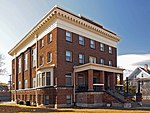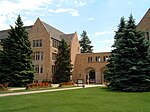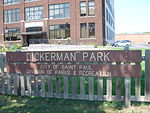Blue Door Pub
2008 establishments in MinnesotaCompanies based in MinneapolisRestaurants in Minnesota

Blue Door Pub is a chain of four restaurants in Minneapolis and Saint Paul, Minnesota, United States. It is known for the Blucy, a variant of the Jucy Lucy. The Blue Door has been featured on Food Paradise, Man v. Food, and Diners, Drive-Ins and Dives. Jeremy Woerner and Pat McDonough opened the first Blue Door Pub in September, 2008. The other four locations opened over the next ten years, with the most recent at the Minneapolis–Saint Paul International Airport.The original Blue Door Pub was located in St. Paul, but closed and did not re-open amidst the covid-19 pandemic.
Excerpt from the Wikipedia article Blue Door Pub (License: CC BY-SA 3.0, Authors, Images).Blue Door Pub
Selby Avenue, Saint Paul Union Park
Geographical coordinates (GPS) Address External links Nearby Places Show on map
Geographical coordinates (GPS)
| Latitude | Longitude |
|---|---|
| N 44.946666666667 ° | E -93.176805555556 ° |
Address
Blue Door
Selby Avenue
55104 Saint Paul, Union Park
Minnesota, United States
Open on Google Maps






